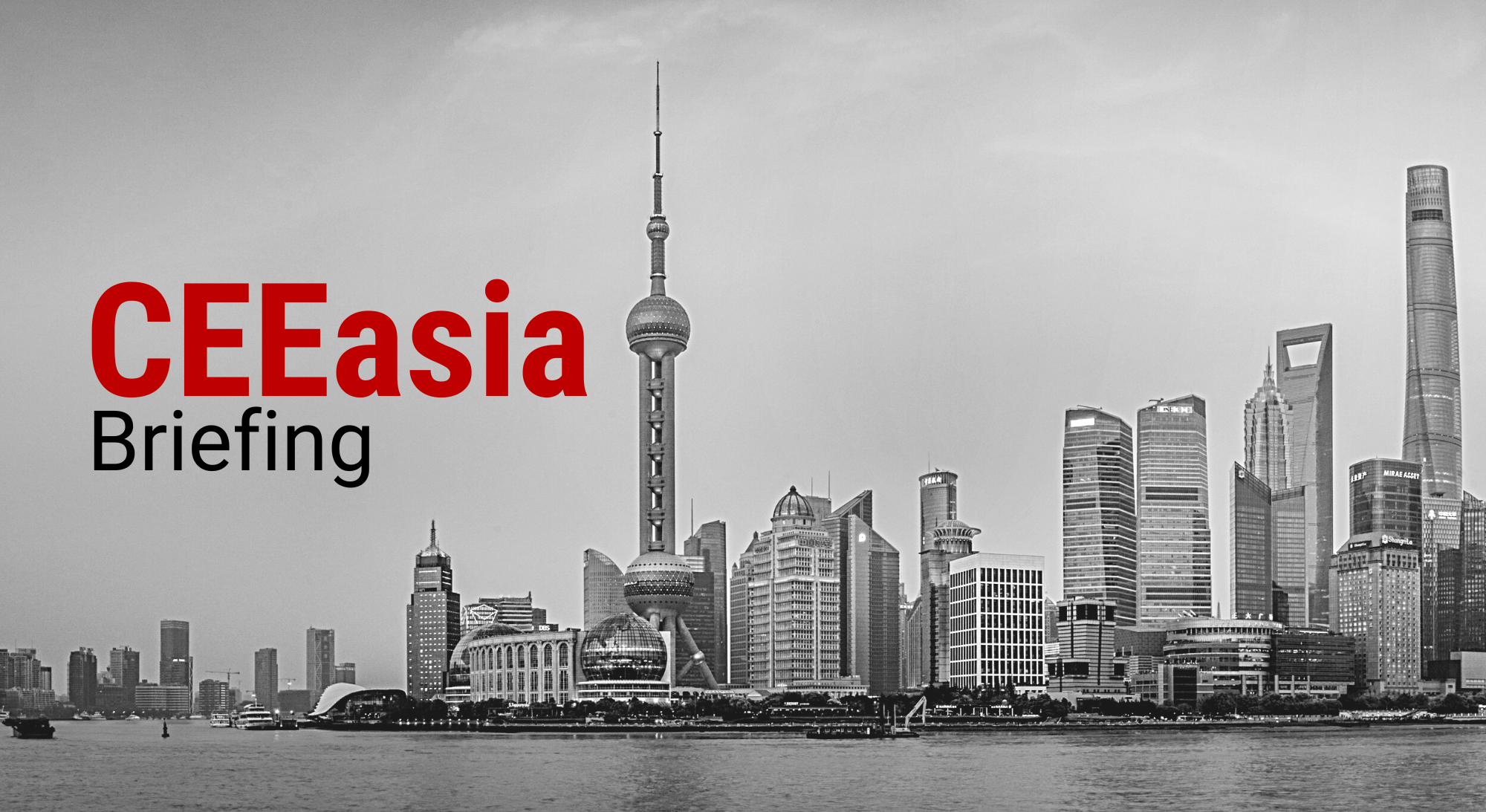Welcome to the 18th issue of the #CEEasia Briefing.
In this issue, we dissect the following topics:
- Protests in Hungary: anti-China backlash?
- China willing to defer repayment of Montenegro’s loan
- Slovenia announces embassy in Seoul
- EU-Japan summit
If you like what you see, please forward this message to your friends and colleagues who can subscribe here.
Do you need to know more about East Asia? Don’t hesitate to shoot us a message about custom analysis tailored to your needs.
1. Protests in Hungary: an anti-China backlash?
What’s going on? Hungarian Minister of Foreign Affairs Péter Szijjártó announced that the national vaccine plant, the opening of which is planned for 2022, will produce the Chinese Sinopharm vaccine. The announcement came during Szijjártó’s visit to China at the end of May, during which he and the foreign ministers of Poland, Serbia, and Ireland met their Chinese counterpart Wang Yi. These visits were described as part of China’s diplomatic offensive towards Europe, starting with the Director of the CCP Central Foreign Affairs Commission and former Foreign Minister Yang Jiechi’s visits to Slovenia and Croatia. Whilst the Chinese government has been trying to appease Europe, especially following Lithuania’s departure from the 17+1 and the European Parliament’s suspension of the CAI ratification, the Hungarian public expressed disappointment with the government’s pro-China policies during early June protests against the planned Fudan University campus in Budapest.
Going deeper… Hungarians protested the government’s plans to finance the construction of the USD 1.7 billion campus through taxpayers’ money, especially considering that the location for the campus was originally meant to host affordable housing for Hungarian students. The protests that drew thousands into the streets, were preceded by the Mayor of Budapest Gergely Karácsony renaming streets surrounding the planned campus after the victims of Chinese human rights abuses, namely Hong Kongers, Tibetans, and Uyghurs. The protests seemed to work, as the government offered to hold a referendum on the campus construction after the 2022 parliamentary elections.
This means… It is not yet known whether the referendum will be national or city-wide and whether it will indeed go ahead considering the established practice by the Prime Minister Viktor Orbán to backtrack on unpopular issues just to return to them once they lose political steam. Nevertheless, the united opposition, which according to the polls stands a chance for the first time since Orbán’s return to power in 2010, is hoping to use Orbán’s controversial relations with China as a framework for larger issues such as corruption and lack of transparency. According to multiple surveys, including the survey by CEIAS & Sinophone Borderlands, there is little support for Orbán’s policies towards China even amongst his supporters. A good example is the overwhelmingly negative attitudes towards the Budapest-Belgrade railway project, which similarly to the campus involved a huge Chinese loan and Chinese contractors. The framing of wider issues within the China issue may therefore turn out to be successful in bringing about a real change in Sino-Hungarian relations.
Further reading:
The Diplomat: Hungarian Policy Toward China Might Be Facing a Seismic Shift
CHOICE: The Fight Over Fudan: A Chinese University in Budapest Sparks Reckoning for Sino-Hungarian Relations
RFE/RL: ‘The Underhanded Sale of Our Sovereignty’: How China Became an Election Issue in Hungary
2. China is willing to defer repayment of Montenegro’s loan
What’s going on? In 2014, Montenegro signed an agreement with a state-run Chinese bank to back most of the cost of a 41-kilometer section of a new highway worth around 1 billion euros. The project is part of the Belt and Road Initiative and has been described as one of the most expensive roads in the world, reaching a cost of around 20 million euros per kilometer. As the Montenegrin government has struggled to repay the first 60-million-euro installment originally due in July, even reaching out to the EU for assistance and preparing to sell off state assets to ease its financial burden, China agreed to defer the repayment until the end of 2022.
Going deeper… The size of the loan that is substantially disproportionate to Montenegro’s GDP has been worrisome as it is threatening to derail the small Balkan economy. What’s more, China’s activities within its BRI megaproject and the 17+1 cooperation have been strongly criticized for causing hidden unmanageable debt for many small countries and lack of transparency with regards to the terms of the provided loans. On the other hand, Chinese officials continuously deny any engagement in ‘debt-trap diplomacy’ and present the funded projects as mutually beneficial.
This means… In fact, both the borrowing governments and China itself are in difficult positions when it comes to the debtor countries’ struggles and inability to repay, especially amidst the coronavirus pandemic. China finds itself under pressure to extend repayment periods or even write off parts of the loans as its own reputation and the significance of the BRI are at stake. Furthermore, Montenegro’s case is the first one in Europe where the borrower faces significant pitfalls of Chinese lending practices. This may lead to other Western Balkan countries becoming increasingly wary of offers of Chinese credit lines for infrastructure construction.
Further reading:
RFE/RL: No Clear Option For Montenegro As It Tries To Repay $1 Billion Highway Debt To China
Reuters: Montenegro counts on EU aid, asset sales to ease burden of China debt
SCMP: Montenegro in ‘final phase’ of talks with Europe to refinance US$809 million debt to China
AidData: How China Lends: A Rare Look into 100 Debt Contracts with Foreign Governments
3. Slovenia announces new embassy in Seoul
What’s going on? Slovenia plans to establish a diplomatic mission in South Korea by the end of 2021. The decision agreed upon at the Slovenia-Korea foreign ministers’ meeting in Seoul at the beginning of June marks an important milestone in the bilateral relationship between both states as it comes just ahead of a 30-year anniversary of diplomatic ties.
Going deeper… So far, Slovenia’s embassy in Tokyo has served as its mission to South Korea while Korea’s embassy in Vienna has been overseeing Slovenian matters. Through the embassy opening, Ljubljana hopes to emphasize the importance of bilateral cooperation with Seoul and further intensify it, especially when it comes to trade, investment, and tourism, as noted by the current Slovenian foreign minister Anže Logar.
This means… Slovenia aims to diversify its presence in Asia as so far it has embassies only in China, Japan, and India. This echoes the EU Strategy for Cooperation in the Indo-Pacific which aims to deepen cooperation between European and Asian countries.
Further reading:
YONHAP: Slovenian FM unveils plan to establish embassy in S. Korea
ROK Ministry of Foreign Affairs: Outcome of Korea-Slovenia Foreign Ministers’ Meeting
4. Outcomes of the EU-Japan Summit
What’s going on? The EU-Japan Summit, which took place on 27 May, was held in the spirit of fighting the pandemic, but also partnership in many areas, from political security, through the Olympic Games, to decarbonization.
Going deeper… Japanese Prime Minister Suga Yoshihide and his European counterparts Charles Michel and Ursula von der Leyen discussed the need for joint action in the fight against the pandemic, but also in the subsequent recovery. The key point of the summit was a joint 9-page communiqué on the so-called Green Alliance. Both sides are committed to achieving the goal of carbon neutrality by 2050, but especially in the case of Japan, it will mean significant changes in the energy sector, as up to 1/3 of its electricity is produced by coal-fired power plants.
Also… The leaders’ summit will also probably cause a stir for its remarks regarding the Indo-Pacific region. The agreement on the “importance of peace and stability in the Taiwan Strait” is historically the first high-level mention of Taiwan between the EU and Japan. In the context of the EU Indo-Pacific strategy, there is a clear signal confirming that the EU will take a critical stance towards China, despite a strong economic relationship.
This means… In recent years, we can see the convergence of cooperation between Japan and the EU. While on trade issues the cooperation is relatively effective, it remains questionable whether this will be the case in other areas. An example is the pursuit of carbon neutrality. Although both parties can benefit from scientific and technological cooperation and joint projects in different parts of the world, it remains questionable how they will resolve the carbon border adjustment mechanism (CBAM) that aims to put a price on imports from countries where it is cheaper to pollute. In addition, the geographical distance and the departure of the United Kingdom from the EU also play a role, which limits the possibilities of EU intervention in the region.
Further reading:
European Council: EU-Japan Summit 2021
Nikkei Asia: Japan and EU name Taiwan in joint statement for first time
Euractiv: EU, Japan seal ‘green alliance’ in bid for climate neutrality







